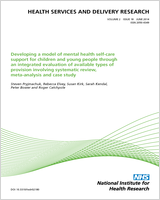Included under terms of UK Non-commercial Government License.
NCBI Bookshelf. A service of the National Library of Medicine, National Institutes of Health.
Headline
The study developed and validated risk prediction models for cardiothoracic and adult (general and specialist) critical care units and for in-hospital cardiac arrest.
Abstract
Background:
National clinical audit has a key role in ensuring quality in health care. When comparing outcomes between providers, it is essential to take the differing case mix of patients into account to make fair comparisons. Accurate risk prediction models are therefore required.
Objectives:
To improve risk prediction models to underpin quality improvement programmes for the critically ill (i.e. patients receiving general or specialist adult critical care or experiencing an in-hospital cardiac arrest).
Design:
Risk modelling study nested within prospective data collection.
Setting:
Adult (general/specialist) critical care units and acute hospitals in the UK.
Participants:
Patients admitted to an adult critical care unit and patients experiencing an in-hospital cardiac arrest attended by the hospital-based resuscitation team.
Interventions:
None.
Main outcome measures:
Acute hospital mortality (adult critical care); return of spontaneous circulation (ROSC) greater than 20 minutes and survival to hospital discharge (in-hospital cardiac arrest).
Data sources:
The Case Mix Programme (adult critical care) and National Cardiac Arrest Audit (in-hospital cardiac arrest).
Results:
The current Intensive Care National Audit & Research Centre (ICNARC) model was externally validated using data for 29,626 admissions to critical care units in Scotland (2007–9) and outperformed the Acute Physiology And Chronic Health Evaluation (APACHE) II model in terms of discrimination (c-index 0.848 vs. 0.806) and accuracy (Brier score 0.140 vs. 0.157). A risk prediction model for cardiothoracic critical care was developed using data from 17,002 admissions to five units (2010–12) and validated using data from 10,238 admissions to six units (2013–14). The model included prior location/urgency, blood lactate concentration, Glasgow Coma Scale (GCS) score, age, pH, platelet count, dependency, mean arterial pressure, white blood cell (WBC) count, creatinine level, admission following cardiac surgery and interaction terms, and it had excellent discrimination (c-index 0.904) and accuracy (Brier score 0.055). A risk prediction model for admissions to all (general/specialist) adult critical care units was developed using data from 155,239 admissions to 232 units (2012) and validated using data from 90,017 admissions to 216 units (2013). The model included systolic blood pressure, temperature, heart rate, respiratory rate, partial pressure of oxygen in arterial blood/fraction of inspired oxygen, pH, partial pressure of carbon dioxide in arterial blood, blood lactate concentration, urine output, creatinine level, urea level, sodium level, WBC count, platelet count, GCS score, age, dependency, past medical history, cardiopulmonary resuscitation, prior location/urgency, reason for admission and interaction terms, and it outperformed the current ICNARC model for discrimination and accuracy overall (c-index 0.885 vs. 0.869; Brier score 0.108 vs. 0.115) and across unit types. Risk prediction models for in-hospital cardiac arrest were developed using data from 14,688 arrests in 122 hospitals (2011–12) and validated using data from 7791 arrests in 143 hospitals (2012–13). The models included age, sex (for ROSC > 20 minutes), prior length of stay in hospital, reason for attendance, location of arrest, presenting rhythm, and interactions between rhythm and location. Discrimination for hospital survival exceeded that for ROSC > 20 minutes (c-index 0.811 vs. 0.720).
Limitations:
The risk prediction models developed were limited by the data available within the current national clinical audit data sets.
Conclusions:
We have developed and validated risk prediction models for cardiothoracic and adult (general and specialist) critical care units and for in-hospital cardiac arrest.
Future work:
Future development should include linkage with other routinely collected data to enhance available predictors and outcomes.
Funding details:
The National Institute for Health Research Health Services and Delivery Research programme.
Contents
- Plain English summary
- Scientific summary
- Chapter 1. Introduction
- Chapter 2. External validation of the current Intensive Care National Audit & Research Centre model in Scottish critical care units
- Chapter 3. Development and validation of a risk prediction model for admissions to cardiothoracic critical care units
- Chapter 4. Development and validation of the new ICNARC model for prediction of acute hospital mortality for admissions to adult critical care units
- Introduction
- Selection of data and candidate predictors
- Handling of missing physiological data in model development and validation
- Development of the new Intensive Care National Audit & Research Centre model
- Validation of the new Intensive Care National Audit & Research Centre model
- Missing data: risk prediction model application in routine practice
- Discussion
- Chapter 5. Development and validation of risk prediction models to predict outcomes following in-hospital cardiac arrest
- Chapter 6. Translation of the risk models into routine practice
- Chapter 7. Conclusions and recommendations
- Acknowledgements
- References
- Appendix 1 Simulation study of missing values
- Appendix 2 The new Intensive Care National Audit & Research Centre model: ICNARCH-2014
- Glossary
- List of abbreviations
Article history
The research reported in this issue of the journal was funded by the HS&DR programme or one of its preceding programmes as project number 09/2000/65. The contractual start date was in July 2011. The final report began editorial review in February 2015 and was accepted for publication in June 2015. The authors have been wholly responsible for all data collection, analysis and interpretation, and for writing up their work. The HS&DR editors and production house have tried to ensure the accuracy of the authors’ report and would like to thank the reviewers for their constructive comments on the final report document. However, they do not accept liability for damages or losses arising from material published in this report.
Declared competing interests of authors
none
- NLM CatalogRelated NLM Catalog Entries
- Ensuring comparisons of health-care providers are fair: development and validati...Ensuring comparisons of health-care providers are fair: development and validation of risk prediction models for critically ill patients
Your browsing activity is empty.
Activity recording is turned off.
See more...
